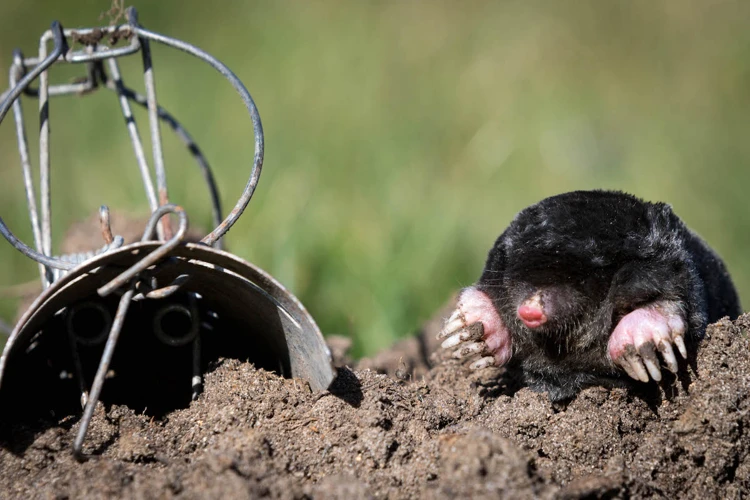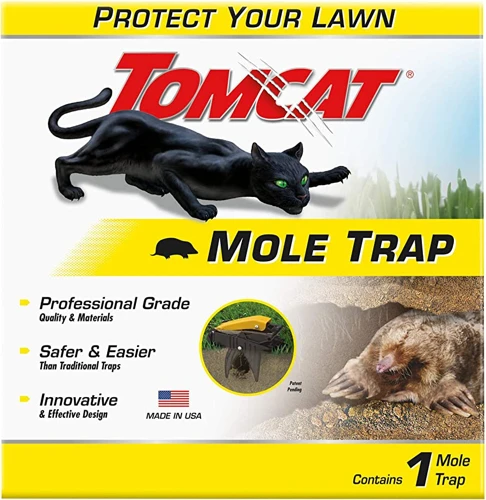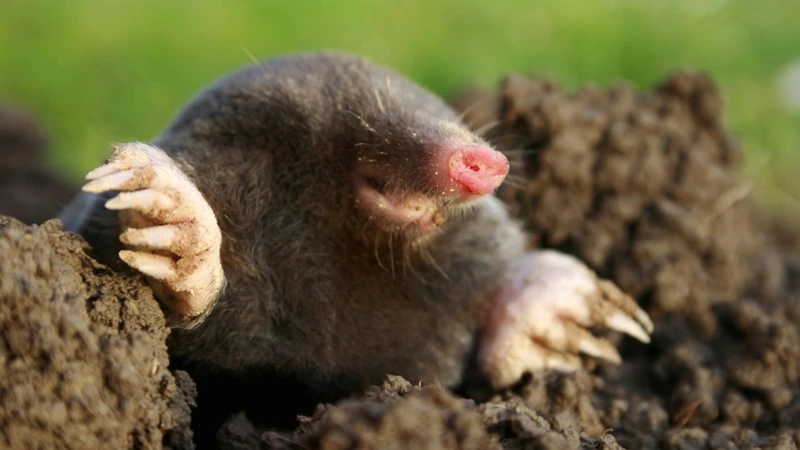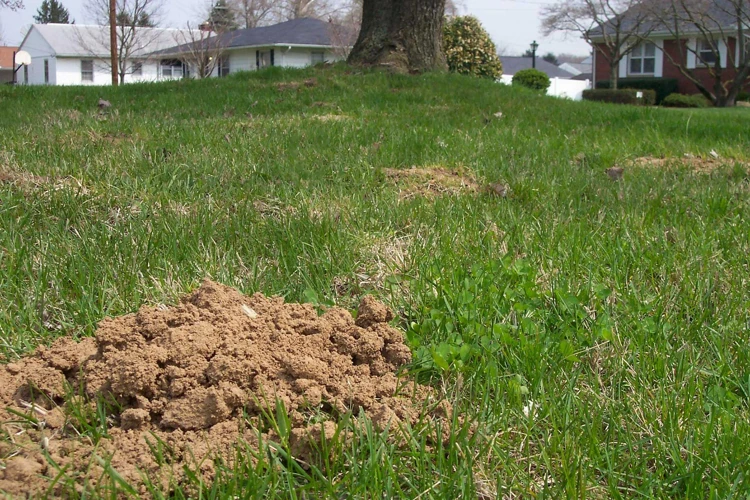Moles, with their underground habitats and subterranean travels, are a source of both fascination and frustration to homeowners and gardeners. They are notorious for tearing up lawns, gardens, and flower beds with their digging and tunneling. Trapping moles is one possible solution, but it is not always an easy task. In fact, it can be quite challenging if not done correctly. In this article, we will delve into the common mistakes that people make when trapping moles and provide a step-by-step guide on how to avoid these mistakes and achieve success in controlling these elusive creatures.
Why Trapping Moles Can Fail

Trapping moles seems like a relatively simple process, but it can be more challenging than it sounds. Many people have attempted to trap moles with little to no success. There are several reasons why trapping moles can fail, which are important to keep in mind for a successful outcome. If you are unsure about why your trapping attempts are not working, or if you are looking for more information about alternatives to trapping, check out our alternatives to killing moles or our mole trap FAQs for expert advice.
Incorrect Placement of Traps
One of the main reasons why trapping moles can fail is due to incorrect placement of traps. It’s important to place the traps in areas where moles are actively tunneling. However, if traps are placed in the wrong area, there is little chance of catching a mole.
Here are a few common mistakes that people make when placing traps:
| Mistake | Description |
|---|---|
| Placing traps in areas that do not have mole activity | It’s important to determine where the moles are tunneling before placing traps. Otherwise, you may be wasting your time and effort. |
| Not digging deep enough when placing traps | When placing traps, it’s important to dig deep enough to accommodate the trap. Otherwise, the mole may be able to escape from the trap. |
| Placing the trap in areas with too much soil compaction | If the soil is too compact, moles may not be actively tunneling in that area. As a result, the trap will be ineffective. |
Avoiding these mistakes when placing traps can increase your chances of successfully trapping a mole.
Choosing the Wrong Type of Trap
One of the most common mistakes that homeowners make while trapping moles is choosing the wrong type of trap. It’s essential to select a trap that will effectively capture moles rather than let them escape.
There are several types of traps available in the market, including harpoon traps, scissor traps, and tunnel traps. However, each type of trap is designed to capture moles differently, and thus, selecting the wrong one can lead to more mole problems.
Harpoon Traps: These traps are designed with sharp prongs that pierce the mole when it steps on them. These are ideal for sandy or loamy soil areas, and they work well in deep tunnels. However, in clay soil or shallow tunnels, it can be challenging to set them correctly.
Scissor Traps: These traps work similarly to the harpoon traps but have blades that close on the mole, killing it instantly. They are easy to set up and work well in sandy soil. However, they are less effective in clay soil as they can become stuck.
Tunnel Traps: These traps are the most common type used to trap moles. They are designed with a metal plate that creates a barrier around a tunnel, forcing the mole to push against it and activating the trap’s trigger. Although it’s easy to set up and operate, it may not work well in sandy soil areas.
It’s critical to select the right type of trap based on the soil type and the extent of the mole infestation. Otherwise, it can lead to frustration and wasted time and money. Use the following table to determine the type of trap that is best suited for your mole infestation situation:
| Type of Trap | Ideal Soil Type | Tunnel Depth | Effectiveness |
|---|---|---|---|
| Harpoon | Sandy or Loamy | Deep | Effective |
| Scissor | Sandy | Shallow or Deep | Effective |
| Tunnel | All Types | Shallow or Deep | Depends on Soil Type |
Always choose the right type of trap to ensure that it is effective in trapping moles, and placement of these traps is also very important.
Incorrect Trap Size
One of the most important factors to consider when trapping moles is choose the correct trap size. Using traps that are too small can result in the mole escaping, while traps that are too big can make the mole hesitant to enter.
To determine the appropriate trap size, it is important to identify the type of mole that is invading your garden or lawn. There are two common types of moles: eastern moles and star-nosed moles. Eastern moles are larger and often require bigger traps, while star-nosed moles are smaller and require smaller traps.
Here is a table summarizing the appropriate trap sizes based on mole type:
| Mole Type | Correct Trap Size |
|---|---|
| Eastern Mole | Medium to Large |
| Star-Nosed Mole | Small to Medium |
Choosing the correct trap size is crucial for trapping moles effectively. By using the appropriate trap size, you increase your chances of catching the mole and preventing future damage to your lawn or garden.
Mistakes to Avoid While Setting Traps

As effective as trapping moles may be, it is crucial to ensure that the traps are properly set. Unfortunately, many individuals make crucial mistakes while setting traps, leading to unsuccessful trapping attempts. To avoid facing similar difficulties, it is important to familiarize yourself with what not to do when setting traps. Here are some common errors to avoid:
Not Wearing Gloves While Handling Traps
When it comes to trapping moles, one mistake you want to avoid is not wearing gloves while handling traps. This may seem like a small detail, but it can actually have a big impact.
When you handle traps without gloves, you leave your scent on them. This can make the traps less effective because the moles will be able to smell your scent and may avoid the area altogether. Additionally, handling traps without gloves can be dangerous because moles have sharp teeth and can bite if they feel threatened.
To avoid this mistake, it’s important to wear gloves every time you handle traps. You can use disposable gloves, which are easy to get and can be thrown away after use, or you can use reusable gloves that can be washed and used multiple times. Just be sure to avoid using gloves that have any holes or tears, as this can compromise their effectiveness.
Here’s a table summarizing the importance of wearing gloves when handling traps:
| Importance of Wearing Gloves When Handling Traps |
|---|
| Leaving your scent on traps can make them less effective |
| Moles can bite if they feel threatened |
| Disposable or reusable gloves can be used |
| Avoid using gloves with holes or tears |
By wearing gloves when handling traps, you can increase your chances of successfully trapping moles and avoid any potential dangers. Don’t overlook this important step in the trapping process.
Not Checking Traps Frequently
One crucial mistake when trapping moles is not checking traps frequently. Checking traps regularly increases the chances of success and reduces the chances of the mole escaping. Here are some reasons why it is important to check traps frequently:
- Preventing Escape: The longer a mole is trapped without checking, the more time it has to try to escape. If the trap is not checked frequently, the mole may successfully escape before it can be captured.
- Safety Concerns: A trapped mole can pose a safety risk to pets and wildlife. Checking traps regularly reduces the risk of unintended harm.
- Success Rate: By checking traps frequently, you can quickly identify when a mole has been captured and remove it. This increases the chances of success in trapping moles.
It is important to check traps at least once a day to ensure you have the best chance of successfully trapping the mole. By doing so, you can increase the chances of success and reduce the chances of injuring the mole or letting it escape.
Traps Are Not Secure
When it comes to trapping moles, it’s important to ensure that the traps are secure. There are several reasons why traps might not be secure, and each reason can result in a failed attempt at trapping moles.
One reason why traps might not be secure is that they aren’t set up properly. If the trap isn’t placed firmly in the ground, the mole might be able to push it aside or knock it over while it’s trying to burrow through the soil. This can result in the trap failing to catch the mole.
Another reason why traps might not be secure is that they’re not anchored properly. If the trap is anchored too loosely, it might move around when the mole tries to burrow near it. This can cause the mole to become suspicious and avoid the trap altogether.
To ensure that traps are secure, follow these tips:
| Tip | Description |
|---|---|
| Use the right size of trap | Traps come in different sizes, and it’s important to choose the right size for the job. A trap that’s too small might not be able to capture the mole, while a trap that’s too big might be too heavy to anchor securely. |
| Anchoring the trap tightly | Make sure that the trap is anchored tightly in the ground. The anchor should be strong enough to keep the trap in place even when the mole is burrowing around it. |
| Choosing the best location | The location of the trap is also important. Choose a spot where you have seen mole activity, and where the soil is soft and easy to burrow through. |
| Camouflaging the trap | Moles are wary animals, and they might avoid a trap that looks like it doesn’t belong in their environment. To make the trap less noticeable, cover it with soil and grass so that it blends in with the surroundings. |
By following these tips, you can increase your chances of trapping moles successfully. Remember that trapping moles takes patience and persistence, but with the right techniques and tools, you can get rid of these pesky animals for good.
Common Mole Control Mistakes

As much as we want to get rid of moles in our lawn, certain mole control practices can actually do more harm than good. Some attempts to control moles can worsen the situation and can even kill off other beneficial organisms in our garden. It is vital to avoid these common mole control mistakes to maintain a healthy and thriving lawn. Let’s take a closer look at some of the most common mole control misconceptions and how to avoid them.
Excessive Soil Moisture
Excessive soil moisture can be detrimental to trapping moles, because it can make the soil softer and more difficult to work with. Excessive soil moisture can make it easier for moles to dig tunnels and create more damage in the garden. It can also make it harder to locate the tunnels and to determine where to place the traps.
Causes of Excessive Soil Moisture
Excessive soil moisture can be caused by various factors, including heavy rain, over-watering of plants, poor drainage, and waterlogging. In most cases, the soil can become waterlogged or over-saturated, making it harder for the water to drain away. As a result, it accumulates in the soil, making it muddy and softer.
How to Fix Excessive Soil Moisture
To fix the problem of excessive soil moisture, it is essential to improve the drainage and ensure that the water drains away from the soil efficiently. One way to do this is to install a drainage system or to create a slope on the ground, so that any water can drain effectively. Additionally, one can reduce the frequency of watering plants and avoid over-watering them.
The following table summarizes the main causes and solutions for excessive soil moisture:
| Causes of Excessive Soil Moisture | Solutions |
|---|---|
| Heavy rain | Install drainage system; Create slope on ground |
| Over-watering of plants | Reduce frequency of watering; Avoid over-watering |
| Poor drainage | Install drainage system |
| Waterlogging | Improve drainage; Create slope on ground |
Excessive soil moisture can make trapping moles more difficult and lead to further damage in the garden. Fixing this problem by improving drainage, reducing watering, and creating a slope on the ground can make it easier to trap moles effectively.
Excessive Usage of Grub and Mole Poison
One common mistake people make when trying to get rid of moles is the excessive usage of grub and mole poison. While these poisons may initially solve the problem, they can actually cause more harm than good. Using too much poison can be harmful to the environment and other animals who may come in contact with it. Repeatedly using poison can actually make moles more resistant to the chemicals, making it harder to get rid of them in the future.
Here are some reasons why excessive usage of grub and mole poison can be problematic:
| Problem | Reason |
|---|---|
| Harmful to environment and other animals | Excessive use of poison can contaminate soil, water, and harm other animals who may come in contact with it. |
| Can increase mole resistance to poison | Overuse of poison can cause moles to develop resistance to it, making it harder to get rid of them in the future. |
| May not solve the root cause of the problem | Using poison may only temporarily solve the problem without addressing the underlying cause of the infestation, such as an abundance of food sources. |
Instead of relying on poison as the sole solution, it is important to identify the root cause of the mole infestation and address it directly. This may include removing their food source, such as grubs, and making changes to their habitat, such as eliminating excess moisture in the soil. Additionally, using proper trapping techniques and prevention methods can help manage mole populations in a more sustainable and effective way.
Starting Too Late
One common mistake that many people make in attempting to trap moles is starting their efforts too late in the season. The timing of mole trapping is crucial to its success, as moles are most active during certain times of the year, making them easier to catch.
Timing is key when it comes to trapping moles. Mole activity is highest in the spring and fall, when they are most actively feeding and building nests. This is when trapping efforts should be focused, as moles are more likely to encounter and trigger traps during these times. Conversely, trapping in the summer and winter months can be less successful, as moles are generally less active and more difficult to catch.
To avoid this mistake, it’s important to plan ahead and begin trapping at the right time of year. Keep in mind that it may take several weeks or even months to eliminate a mole infestation, so it’s best to begin as early as possible. Checking for mole activity in the yard, such as tunnels and mounds of soil, can help you determine when to start your trapping efforts.
| Common Mistake | Consequence | Solution |
|---|---|---|
| Starting too late in the season | Low chances of catching moles, resulting in prolonged infestation | Begin trapping in the spring or fall when moles are most active |
Avoiding the mistake of starting too late can help ensure success in trapping moles and preventing further damage to your lawn or garden. By focusing on timing and taking a proactive approach to mole trapping, homeowners can effectively control mole populations and maintain a healthy outdoor environment.
How to Avoid Trapping Moles in the Future
If you’re tired of dealing with mole infestations on your lawn, there are several methods you can employ to avoid trapping moles in the future. By implementing prevention techniques and using proper methods to trap moles, you can minimize the chances of moles returning and causing further damage to your outdoor space. In this section, we’ll discuss some effective strategies for mole control to help you maintain a mole-free lawn.
Using Prevention Techniques
One of the most effective ways to avoid trapping moles in the future is to use prevention techniques . Here are some methods that can help:
| Technique | Description |
|---|---|
| Reduce Soil Moisture | Since moles thrive in moist soil, reducing soil moisture can make your lawn less attractive to the pests. Ensure proper drainage and avoid overwatering the lawn. |
| Remove Food Sources | One of the main reasons moles invade your lawn is to hunt for food. Removing food sources such as grubs, insects and worms can discourage them from invading. |
| Regular Lawn Mowing | Moles love to tunnel and burrow in tall grass. Regularly mowing the lawn to keep it short eliminates hiding spots for moles and make it easier to spot the trails created by burrowing. |
| Physical Barriers | Installing physical barriers such as hardware cloth at the bottom of planting beds can prevent moles from burrowing beneath them. Fencing can create a boundary that can prevent moles from entering specific areas of a garden or lawn. |
By implementing these prevention techniques, homeowners can keep their lawns and gardens healthy by preventing mole infestations. Not only will this save time and effort that would have been used in trapping the moles, but also prevent costly damage to gardens and lawns from the burrowing activities of these pests.
Using Proper Techniques to Trap Moles
Effective mole trapping requires the use of proper techniques. Here are some important things to consider when trapping moles:
| Technique | Explanation |
|---|---|
| Locate active mole tunnels | Before setting traps, it’s important to locate active mole tunnels. One way to do this is by stepping on any raised tunnels in your yard and marking the area. After a day or two, check to see which tunnels have been repaired, indicating they are still in use. |
| Choose the proper trap | There are different types of mole traps available in the market. It’s important to choose the right trap based on the size of the moles and the location of the tunnels. For example, scissor traps are ideal for shallow tunnels, while harpoon traps are suitable for deeper ones. |
| Set traps in multiples | As moles have multiple tunnels, it’s important to set traps in multiples to increase your chances of success. Setting traps in different directions can also increase your chances. |
| Place the trap properly | Once you have located an active tunnel and chosen the right trap, place the trap carefully inside the tunnel. Make sure to follow the manufacturer’s instructions for setting the trap. |
| Check traps frequently | It’s important to check traps frequently to ensure that any trapped moles are removed as soon as possible. Leaving a trapped mole for too long can attract other predators and make the situation worse. |
By following these proper techniques, you can increase your chances of successfully trapping moles and reducing their population in your yard.
Conclusion
In conclusion, trapping moles can be a challenging task, but by avoiding common mistakes and following proper techniques, it can be accomplished successfully. It’s essential to choose the right type and size of the trap and place them strategically in the mole’s pathways. Always wear gloves while handling the traps and check them frequently to ensure that they are secure and effective.
Additionally, preventing moles in the first place can be an effective long-term solution. Maintaining proper soil moisture levels and avoiding excessive use of grub and mole poison can also help deter moles from your yard. Starting early in the season can also be beneficial in preventing mole damage.
It’s essential to remember that trapping and controlling moles require patience and perseverance. It may take some trial and error to find the right techniques that work for your situation. However, by using the proper methods, you can trap and control moles effectively.
Overall, by avoiding common mistakes and using the proper techniques, trapping moles can be a successful endeavor. Taking preventative measures can also help deter moles from returning in the future. With some patience and persistence, you can have a mole-free yard.
Frequently Asked Questions
How long does it take to trap a mole?
Trapping results depend on several factors, such as the number of moles, soil moisture, and time of the year. It can take a few days to even a few weeks to completely trap all of the moles.
Why is it important to wear gloves while handling traps?
Wearing gloves while setting or adjusting traps is important to avoid leaving human scent on the trap. Moles have a keen sense of smell and can easily detect foreign scents, which can lead to the mole avoiding the trap.
How frequently should I check my traps?
It is recommended to check traps at least once a day. The more frequent the checks, the better chance of successfully trapping the mole.
Is it better to set traps in mole tunnels or surface runways?
It is better to set traps in mole surface runways as they are more frequently used by moles for travel and searching for food. Tunnels may be abandoned or connected to multiple areas, making it harder to trap the mole.
What is the best time of year to trap moles?
Spring and fall are generally the best times of year to trap moles as they are more active during these seasons. Summer and winter months can present challenges due to either drought or frozen soil.
Can I use grub or mole poison to control moles?
While grub and mole poison may be effective in controlling other pests, such as grubs, they are not effective in eliminating moles. Additionally, using poison can harm other animals that may come into contact with it.
How can I prevent moles from returning?
Prevent moles from returning by eliminating their food source, such as grubs or insects, and creating barriers with hardware cloth or mesh to prevent them from burrowing into areas you don’t want them.
What are the most effective types of traps for trapping moles?
The most effective types of traps for trapping moles are harpoon and scissor traps. Both types quickly and humanely kill the mole and are designed for easy use and disposal.
Do I need a professional to trap moles?
While professionals may have more experience and expertise in trapping moles, it is possible to successfully trap moles on your own with the proper tools and techniques.
Are there any legal restrictions on trapping moles?
There may be specific laws and regulations in your state or country that regulate trapping of moles. Be sure to check with your local authorities before trapping moles to avoid any legal issues or fines.







